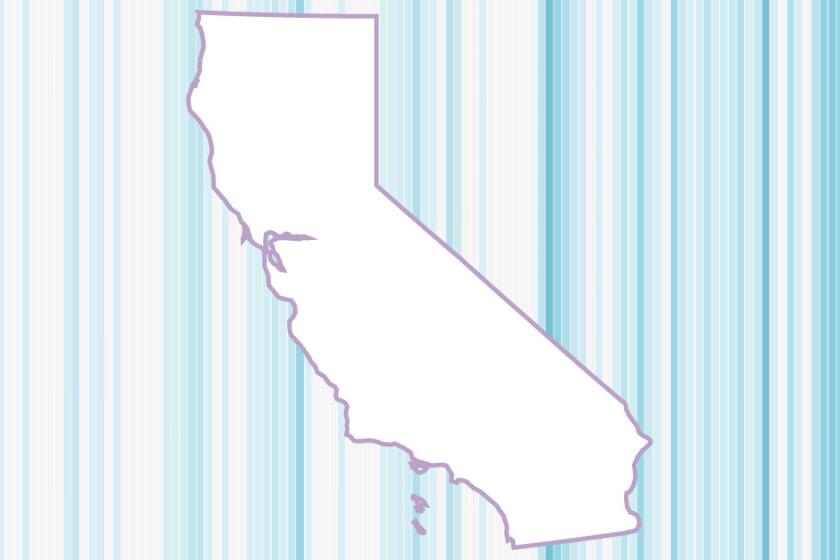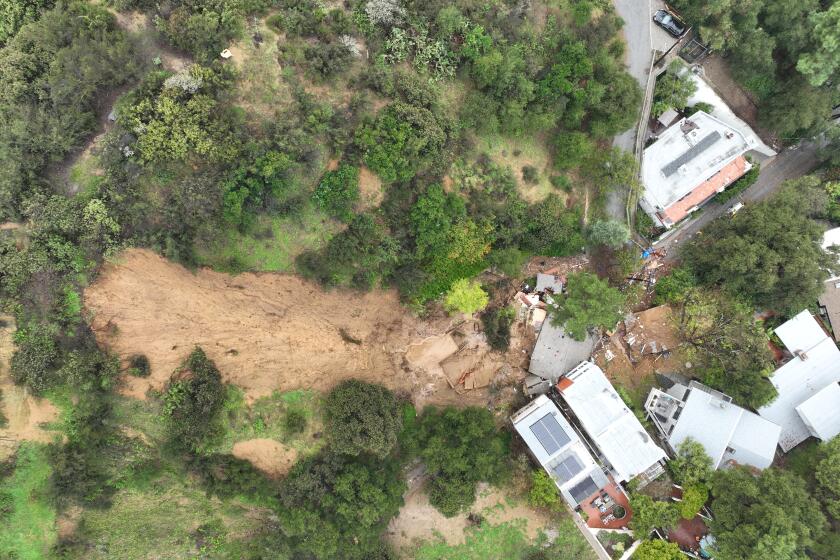Record rain saturates SoCal landscape, heightening fears of more landslides

- Share via
Already inundated by record rainfall, Southern California is facing another major storm Presidents Day weekend that could bring new risks for mudslides and flooding in vulnerable areas saturated with water.
The region saw 2 to 15 inches of rain last week — precipitation that weakened hillsides, closed roads and damaged homes. And while the strength of this new storm is still far from clear, experts say it underscores the dangers for slide-prone areas in the weeks and months ahead.
The National Weather Service office in Oxnard said it is still assessing the weekend forecast but said there is the possibility of “significant flooding and mudslides,” with a “potential for coastal flooding and damaging waves” and a moderate risk of falling trees and power outages.
Vulnerable areas include Malibu, where Pacific Coast Highway was damaged, the Hollywood Hills neighborhoods and parts of coastal south Orange County, where landslides have endangered homes and blocked key railroad tracks. Other areas hit hard by sliding mud included Baldwin Hills and Hacienda Heights.
Sunday night through Monday is expected to be the most concerning, with risks lasting perhaps into Tuesday.
With the ground already saturated from recent storms, some locations could be at risk for further landslides and swift-moving flows of mud if rain this weekend falls at high rates of intensity — perhaps as much as 1 inch of rain per hour.
The most likely scenario as of Wednesday is that the weekend storm will move relatively slowly, dumping rain for one to two days, said meteorologist Ryan Kittell of the National Weather Service’s Oxnard office.
But it also could move faster, limiting rain over 12 to 24 hours. There’s also a small chance the storm could remain largely over the ocean, bringing less overall rain over Southern California, but that could bring more thunderstorms — and the chance of brief, heavy downpours.
Ahead of the upcoming storm, city officials in Malibu announced Wednesday they would be shutting down a 6-mile stretch of Pacific Coast Highway every night because of erosion, high tides and damage from the last storm.
Forecasters estimated the weather risk will be major — the second-highest level — for Los Angeles, Ventura and Santa Barbara counties on Monday and Tuesday.
Minor risks are expected for San Diego, Orange, Riverside and San Bernardino counties.
As Californians face non-stop rain from an atmospheric river this week see how rainfall totals in your area compares to other regions and previous years.
Last week’s storms hit certain neighborhoods particularly hard with eye-popping accumulation in some parts. Nearly 14 inches dropped on Bel-Air over five days. Such enormous levels of precipitation can wreak havoc in densely built neighborhoods built into hillsides, which are especially vulnerable to landslides.
Many of the slides last week occurred in areas where hill slopes “might have conditions that predispose them to the landslides more so than normal,” said Matt Thomas, a research hydrologist with the U.S. Geological Survey’s landslide hazards program. “So you can have oversteepened slopes, poorly developed fill that erode where a house is sitting on. You can have site-drainage conditions that funnel water ... into areas that end up eroding and therefore causing landslides.”
In the canyons north of UCLA, residents are bracing themselves.
Dave Christensen woke around 2 a.m. Feb. 5 to the sound of crackling outside his bedroom window and then what sounded like an explosion. When he looked out, he realized his neighbor’s water heater was just a few feet from his view. The rest of his neighbor’s house, on Caribou Lane off Beverly Glen Boulevard, had collapsed and slid down the hill in pieces, sending mud into his garage.
Since then, Christensen has been staying with family and friends while trying to get answers about what will happen to the home he moved into seven years ago.
So far, the damage to his house seems to be contained to the garage and the front stairs, but he’s worried the approaching storm will make things worse.
For days, Christensen said, he’s been trying to get hold of city officials, hoping to get some of the debris removed before the next storm.
On Tuesday, officials with the Los Angeles Department of Building and Safety told him they were devising plans to demolish and remove his neighbor’s home so he could shore up his own house. Work was set to begin Friday.
But that will mean much of the debris will probably still be there when the next storm hits.
“We’re nervous about that,” he said.
A couple of key ingredients can increase the risk of landslides and mudflows. A big reason why areas like the Hollywood Hills were hit hard has to do with high levels of accumulated rainfall during the storm.
But rainfall intensity — the amount of rain that falls per hour — was actually not very high last week, Thomas said.
“That’s probably what made the difference between news stories that were reporting a lot of landslides in neighborhoods versus widespread land sliding across all of the mountain ranges in a much more widespread event,” Thomas said.
The city was still working its way through 562 mudslides as of Wednesday evening. Burn scars, loose earth and improper construction are all factors.
The forecast has raised red flags in Orange County.
Three multimillion-dollar estates perched high on the edge of a Dana Point bluff boast some of the most magnificent views in Orange County: unobstructed panoramas of the crystal blue Pacific, boats moored in the harbor and, on a clear day, Santa Catalina Island.
But there are fresh concerns about the homes on the aptly named Scenic Drive. The same steep cliff that falls away under the properties — giving them the illusion of being on the edge of the Earth — has withered under the atmospheric river precipitation that pounded Southern California last week. A portion of the cliff leading up to the blufftop homes washed away in the torrent.
None of the homes has been evacuated or deemed too dangerous to occupy — even with more rain in the forecast, officials said.
Lewis Bruggeman, who owns the home just above the slide area, told KCAL-TV Channel 9 that his house is “not threatened and it will not be red-tagged.”
“The city agrees that there’s no major structural issue with the house right now,” he told the station. Bruggeman did not respond to a request for comment from The Times.
The slide erased the greenery that until recently backed up to Bruggeman’s home, a 9,700-square-foot compound estimated to be worth nearly $16 million, leaving only sandy soil behind. On Tuesday, piles of rocks and dirt sat on the shoreline below.
The city’s geotechnical engineer and a building inspector have visited the home to assess the slope failure, according to Dana Point officials.
“Engineers who already surveyed the home said there was no damage and there is no imminent threat to the structure, which is really good news,” Mayor Jamey Federico said. “So quite frankly, it looks a lot scarier than it really is.”
Steve Viani, a civil engineer who has experience with landslides, said tarps should be placed over the bare soil on the Dana Point property and pipes should be installed on gutters and downspouts to carry water away from the building foundation ahead of this weekend’s storm.
Prolonged rain on the bare soil could further damage the slope, he said, adding that it could “give way at any time.”
Billy Prescott, 56, who spent 25 years living in Dana Point before relocating to Idaho, said he’d come to expect landslides and ground movement along the coast — particularly during El Niño years.
“It’s just Mother Nature,” he said. “You don’t always win going up against her.”
More to Read
Sign up for Essential California
The most important California stories and recommendations in your inbox every morning.
You may occasionally receive promotional content from the Los Angeles Times.















